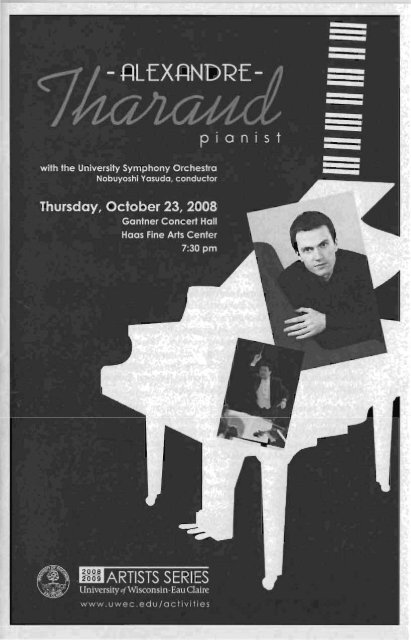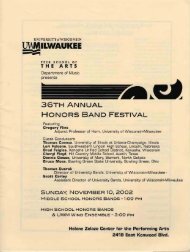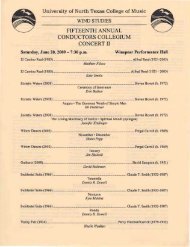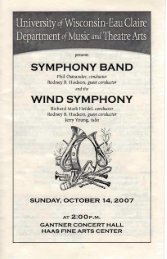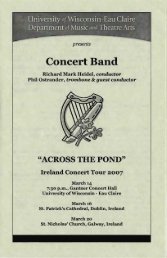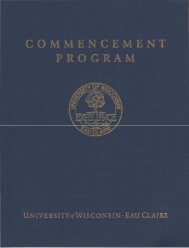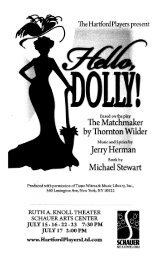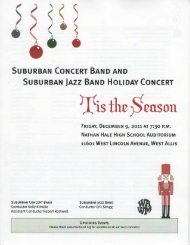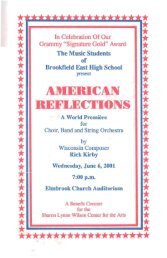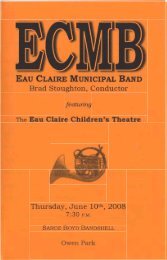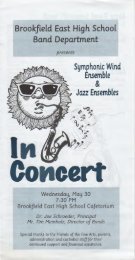about alexandre tharaud - Jim Skaleski
about alexandre tharaud - Jim Skaleski
about alexandre tharaud - Jim Skaleski
Create successful ePaper yourself
Turn your PDF publications into a flip-book with our unique Google optimized e-Paper software.
ABOUT ALEXANDRE THARAUD<br />
Alexandre Tharaud graduated from the Conservatoire National Superieur<br />
de Musique in Paris and started his international career in earnest when he<br />
won the second Prize at the ARD Music Competition in Munich.<br />
As a soloist, he has performed with the Symphonieorchester des Bayerischen<br />
Rundfunks, Munchner Rundfunkorchester, Japan Philharmonic Orchestra,<br />
Tokyo Metropolitan Orchestra, Orchestre Philharmonique de Radio<br />
France, Orchestre National de France, Orchestre National de Lille,<br />
Orchestre National de Bordeaux-Aquitaine, Ta'iwan National Symphony<br />
Orchestra, Orchestre du Capitole de Toulouse, Orchestre Philharmonique<br />
de Nice, Singapore Symphony Orchestra, the Orchestre National de Lyon,<br />
Netherlands Chamber Orchestra, Estonian National Symphony Orchestra,<br />
and Rundfunk-Sinfonieorchester Saarbrucken.<br />
In recent seasons, Tharaud has performed at such festivals as 'Piano<br />
aux Jacobins: La Roque d'Antheron, BBC PROMS, Lufthansa Festival of<br />
Baroque Music, Sacrum-Profanum in Krakow, Schleswig-Holstein, Rimini,<br />
Festival de musique ancienne de Saintes, Printemps de Monte-Carlo and<br />
the Festival Verano Musical de Canarias.<br />
He has made his recital debut at the K61n Philharmonie, the Essen<br />
Philharmonie, the South Bank piano series and the Rudolfinum in Prague.<br />
He has also appeared at the Theatre des Champs-Elysees, Teatro Colon<br />
in Buenos Aires, Concertgebouw in Amsterdam, the Kennedy Center in<br />
Washington, D.C., Bern Casino, Cite de la Musique, Krakow Philharmonie,<br />
and Hoam Art Hall in Seoul.<br />
Tharaud's adventurous approach to programming has resulted in a number<br />
of commissions and premiers; he has toured extensively in Europe with his<br />
'Hommages aRameau' program, and premiered his 'Hommage aCouperin'<br />
featuring works by the composer with pieces by Gagneux, Pesson, Mache,<br />
2
PROGRAM<br />
MUSIC BY MAURICE RAVEL 1875- 1937<br />
50nantine(1903-190~<br />
Modere <br />
Mouvement de menuet <br />
Anime <br />
Miroirs (1904-1905)<br />
Noctuelles <br />
Oiseaux tristes <br />
Une barque sur I'ocean <br />
Alborada del gracioso <br />
La vallee des cloches <br />
Le Tombeau de Couperin (1914-1917)<br />
Prelude<br />
Fugue<br />
Forlane<br />
Rigaudon<br />
Menuet<br />
Toccata<br />
INTERMISSION<br />
Piano Concerto in G major (1929-1931)<br />
Allegramente<br />
Adagio assai<br />
Presto<br />
Hersant and Lenot at the Theatre de la Ville in<br />
Paris in May 2008. In October 2006, he gave<br />
the world premiere of Thierry Pecou's piano<br />
concerto, l'Oiseau Innumerable, at the Theatre<br />
des Champs-Elysees.<br />
His Harmonia Mundi recordings dedicated to<br />
the music of Rameau, Ravel, Bach, Chopin and<br />
Couperin (the celebrated Tic, Toe. Choc) have<br />
received great critical acclaim. The Ravel was<br />
greeted with the highest awards from the press<br />
and resulted in invitations for performances<br />
worldwide.<br />
C <br />
~F~ ~ <br />
w df~O~<br />
l><br />
....<br />
n ~<br />
3
PROGRAM NOTES <br />
SONATINE<br />
Ravel's inspiration for composing his Sonatine was a 1903 competition<br />
sponsored by a fine arts and literary magazine called Weekly Critical Review.<br />
Ravel's close friend, critic M. D. Calvocoressi, was a contributor to the<br />
publication and encouraged Ravel to enter the competition. The requirement<br />
was a first movement of a piano sonatina no longer than 75 measures, and<br />
the prize offered was 100 francs. The magazine was nearing bankruptcy at<br />
the time and ultimately the publisher canceled the competition. Ironically,<br />
Ravel would have probably won the competition since he was the only<br />
entrant, but his first movement was a few measures too long.<br />
Ravel dedicated the Sonatine to his dear friends Ida and Cipa Godebski.<br />
Madame Paule de Lestang gave the world premiere of the work in Lyon,<br />
France on March 10, 1906. It was premiered in Paris shortly afterward by<br />
Gabriel Grovlez at a concert on the series of the Societe Nationale de<br />
Musique at the Schola Cantorum. The Sonatine quickly became popular<br />
with audiences and Ravel performed the first two movements regularly on<br />
concert programs across Europe and during his tour of America in 1928.<br />
The Sonatine is Ravel's homage to late 18th-century musical elegance<br />
and classical structure. It is a cyclical work that uses a recurring motive.<br />
The opening theme of the first movement is transformed in the two<br />
subsequent movements-a technique refined by Liszt, whom Ravel<br />
greatly admired for that compositional device as well as for his virtuosity<br />
(c.f. Jeux d 'eau and La valse).<br />
The second movement minuet lacks the traditional trio section, perhaps<br />
in keeping with the abbreviated nature of a sonatina. Its modal inflections<br />
recall an earlier Ravel work, the Menuet antique of ten years before. Ravel<br />
told his pianist friend Marguerite Long to play this minuet "in the tempo<br />
of the minuet of Beethoven's E-flat Piano Sonata, Op. 31 No.3" (which<br />
is marked Moderato e grazioso). Ravel emphasizes the upbeat accents of<br />
the theme (as he did in the first movement). These accents, coupled with<br />
an aristocratic tempo, prevent this movement from becoming a waltz.<br />
The last movement is a tour de force of brilliant virtuosic writing for the<br />
piano. It is a perfect example of a toccata and is the musical descendant<br />
of the works of the French claveciniste composers to whom Ravel felt<br />
spiritually connected (Hameau and Couperin). It is strikingly similar to<br />
Debussy's Mouvement from the first book of Images and the Toccata from<br />
his Pour Ie Piano suite. Ravel would later enlarge the proportions of this<br />
sonatina's toccata to become the Toccata of Le Tombeau de Couperin,<br />
a work of Lisztian virtuosity.<br />
4
MIROIRS<br />
Ricardo Vines first performed Miroirs (Mirrors) in 1906. Each movement<br />
was intended to manifest the visual images and ambience evoked when<br />
a certain person (those who received the dedications) looked into the<br />
mirror. With further insight into the piece, it might be surmised that the<br />
reflections are revealing parts of Ravel himself being projected onto these<br />
separate beings.<br />
• Noctuelles (Night Moths), dedicated to Leon-Paul Fargue - This<br />
piece begins with highly chromatic pianissimo scampering across the<br />
keyboard. The calmer middle section makes use of chordal melodies<br />
and a pedal point; this is followed by a return to the introductory<br />
material.<br />
• Oiseaux tristes (Sad Birds), dedicated to Ricardo Vines - A lone bird<br />
sings its sad song at the beginning; other birds reluctantly join. The wild<br />
and raucous middle section is offset by a slow, solemn cadenza, which<br />
returns the piece to the solitude and loneliness of the opening.<br />
• Une barque sur I'ocean (A Boat on the Ocean), dedicated to Paul<br />
Sordes, a painter and fellow member of the Apaches - This piece is<br />
based around a flowing arpeggio, with simultaneous melodies in the<br />
upper and middle registers. The next section changes key abruptly, and<br />
a muted climax is followed by a striking passage: a tremolo in the right<br />
hand is accompanied by a tremendous arpeggio in the left hand; when<br />
the two meet at fortissimo at the top of the register, they cascade back<br />
down the piano. The central section of the piece is based around an<br />
ostinato in the extreme upper register; this forms the accompaniment<br />
for a Spanish melody. The accompaniment and melody become more<br />
insistent, until a fortississimo climax is reached. The tension slowly gives<br />
way, and the opening theme returns, providing the piece with a sense<br />
of calm and closure.<br />
• A/borada del gracioso (The Comedian's Aubade), dedicated to M.<br />
D. Calvocoressi, the provider of the text to Ravel's Cinq melodies<br />
popu/aires grecques - This piece is heavily influenced by Spanish<br />
themes, with the introductory chords reminiscent of guitars. The piece<br />
is marked by sharp dynamic and textural contrasts; it contains both<br />
stunning melodies and passages of considerable virtuosity.<br />
• La vallee des cloches (The Valley of Bells), dedicated to Maurice<br />
Delage, Ravel's first pupil - It is believed that the inspiration of the<br />
piece lay in the sound of church bells, though it is unknown whether<br />
Ravel's "Valley" is Swiss or French. Ravel evokes many different bells<br />
throughout this piece; from the delicate bells of the opening to the<br />
quietly booming bells of the close. Some of Ravel's most striking<br />
melodies occur in this piece, often with lush harmonizations.<br />
5
N<br />
0<br />
z<br />
--'<br />
W<br />
><br />
«<br />
UJ '"<br />
U<br />
:::><br />
'" «<br />
~<br />
LE TOMBEAU DE COUPERIN<br />
In this extraordinary work, which is conceived as a Baroque suite,<br />
Ravel pays homage to the rich tradition of French Baroque music<br />
for the harpsichord, as exemplified by the works of Franc;:ois<br />
Couperin . It was certainly not Ravel's intention to imitate<br />
Couperin, or any other Baroque composer; instead, he included<br />
elements of Baroque style without altering his own unique style.<br />
While Ravel's pianism is unmistakably modern, his refined, meticulous<br />
approach to the keyboard clearly shows an affinity with the French<br />
Baroque masters. However, the word "tomb" in the title also had a<br />
deeper personal significance for Ravel, who dedicated each movement<br />
of the suite to a friend who died in World War I.<br />
6
The manuscript is dated 1914 -1917, so it is difficult to determine if any<br />
significant portions of the work were written before the war. At any rate,<br />
Ravel intended the composition as a memorial to his friends; while there<br />
are moments of lightness and humor in this music, which prompted some<br />
to criticize the composer's supposedly irreverent attitude toward death,<br />
beneath the flashes of wit one hears profound melancholy tones in the<br />
returning soldier's tribute to his fallen comrades.<br />
Dedicated to Lieutenant Jacques Charlot, who worked for Ravel's<br />
publisher Durand, the Prelude is a veritable whirlpool of sound, the<br />
sensation of fluidity created by elegantly executed triplet figurations.<br />
A triplet figure also appears in the noble, marmoreal Fugue, dedicated to<br />
Lieutenant Jean Cruppi, whose mother had played an important role in<br />
the production of L'Heure espagnole. Deceptively simple, this movement<br />
is a demanding polyphonic construction which Ravel executes with his<br />
characteristically brilliant nonchalance.<br />
The Forlane, the French variant of an old Italian dance, bears a dedication<br />
to Lieutenant Gabriel Deluc, a friend from St-Jean-de-Luz, in Ravel's<br />
native Basque region. As Vladimir Jankelevitch remarked, this noble<br />
and melancholy movement is like a lullaby. However, there is something<br />
slightly jarring and manic in this lullaby, and the manic energy turns into a<br />
nervous - but infinitely charming - narrative, the Rigaudon.<br />
Dedicated to Ravel's St-Jean-de-Luz friends Pierre and Pascal Gaudin, two<br />
brothers who were killed by the same shell on their first day of combat,<br />
the Rigaudon is named after an ancient Provenc;al dance. This movement<br />
opens with a poignant figuration, which, recurring with the power of an<br />
irresistible fixation, defines the identity of the entire piece.<br />
Ravel dedicated the Menuet to Jean Dreyfus, step-brother of the<br />
composer and critic Roland-Manuel. Unfolding with the calm pace of an<br />
unassuming narrative, this movement, despite its apparently peaceful<br />
simplicity, unveils, if only for a moment, feelings of mournful foreboding.<br />
The final movement, Toccata is dedicated to Captain Joseph de Marliave,<br />
husband of Marguerite Long and devoted admirer of Faure's music. In this<br />
movement, the half-hidden disquietude of the entire composition finally<br />
comes to the fore. While the percussive, obsessively recurring figurations<br />
may define this movement as a composition dominated by technical<br />
demands, there are, trapped in a carapace of busy, hammering gestures,<br />
enchanting moments of quiet lyricism.<br />
Marguerite Long gave the first performance of Le Tombeau de Couperin<br />
in 1919; that year, Ravel completed his brilliant orchestration of the<br />
Prelude, Foriane, Minuet and Rigaudon, adding splendid orchestral color<br />
to these exquisite musical creations.<br />
SOURCE: ALL MUSIC GUIDE<br />
7
PIANO CONCERTO IN G MAJOR<br />
Ravel's two concertos for piano - this one in G and the one in D for the<br />
left hand alone - were composed in the years 1929-1931. Except for the<br />
song-cycle Don Quichotte a Dulcinee, which followed in 1932, they were<br />
his last compositions in any form. The Concerto in G was begun first, but<br />
the Left-Hand Concerto was the first to be completed. At <strong>about</strong> the time<br />
he finished the two scores, Ravel spoke of them in an interview with a<br />
correspondent for the Daily Telegraph of London:<br />
It was an interesting experience to conceive and realize the two<br />
concertos at the same time. The first [the G major]. which I propose<br />
to play myself, is a concerto in the strict sense, written in the spirit<br />
of Mozart and Saint-Saens. I believe that a concerto can be both gay<br />
and brilliant without necessarily being profound or aiming at dramatic<br />
effects. It has been said that the concertos of some great classical<br />
composers, far from being written for the piano, have been written<br />
against it. And I think this criticism is quite justified.<br />
At the beginning, I meant to call [the G major] a "divertissement,"<br />
but afterwards I considered that this was unnecessary, as the name<br />
Concerto adequately describes the kind of music it contains. In some<br />
ways my Concerto is not un'l,ike my Violin Sonata; it uses certain<br />
effects borrowed from jazz, but only in moderation.<br />
According to M.D. Calvocoressi, the musical scholar and friend of Ravel,<br />
the G-major Concerto was "the belated materialization of a plan that<br />
ever since his youth Ravel had kept at the back of his mind. His intention<br />
was to play the solo part himself, and in 1931 he had an extensive tour all<br />
mapped out: it was to carry him as far as Japan."<br />
The tour never took place. Ravel acknowledged that he was not a virtuoso<br />
in the league of Mozart and Saint-Saens, and he gave the Concerto in<br />
G to Marguerite Long. She introduced it at the Salle Pleyel, with Ravel<br />
conducting, on January 13, 1932, just five days after Paul Wittgenstein<br />
gave the premiere of the Left-Hand Concerto in Vienna, and then<br />
recorded it with Ravel and performed it with him all over Europe.<br />
In his authoritative little book on Ravel, Alexis Roland-Manuel (1891<br />
1966), who was his pupil, friend and confidante for some 26 years, and<br />
whose judgments are candid as well as affectionate, expanded upon<br />
Ravel's own remarks on this work:<br />
The Concerto in G major follows out the composer's intentions very<br />
closely. It is a virtuoso "divertissement," brilliant, clear and light,<br />
with sharp contrasts which navigate with Mozartean ease the classic<br />
difficulties presented to free recapitulation by the formal sonata.<br />
8
The initial Allegramente, with its astounding vigor, imposes a hard<br />
and energetic harmonic "climate" upon melodic lines which, in their<br />
delicacy and capacity for easy adjustment, are related not so much to<br />
the Sonata for Violin and Piano as to Ma Mere l'Oye and Ondine.<br />
Some critics have professed to find the contrast of the Adagio assai and<br />
the two movements which bound it incongruous. In a work free of "cyclic"<br />
writing, it is as legitimate a contrast as the precisely similar example in the<br />
Larghetto of Mozart's Clarinet Quintet, which Ravel took as his model.<br />
The Adagio is really a Lied whose calm contemplation brings it unusually<br />
close to Faure's musings. The composer confessed to Mme. Long, when<br />
she praised the free development of the leisurely melody, which she felt<br />
came on naturally, that he had written it "two bars at a time, with frequent<br />
recourse to Mozart's Clarinet Quintet." But, once again, the original had<br />
become absorbed into the pastiche and entirely disappeared.<br />
The conclusion is heralded by a terse Presto, at once brilliant, brief and<br />
scintillating - a chase goaded by galloping fanfares and not to be halted<br />
by the nasal tattoo of jazz. It is a violent struggle between meter and<br />
rhythm - the apotheosis of tonality.<br />
SOURCE: RAVEL, BY ROLAND-MANUEL, TRANSLATED BY CYNTHIA JOLLY. PUBLISHED IN<br />
PAPERBACK BY DOVER PUBLICATIONS, INC., THROUGH ARRANGEMENT WITH DOBSON<br />
BOOKS, LTD., LONDON,<br />
A scintillating,<br />
unconventional young<br />
French pianist worth<br />
watching ... In the<br />
two-CD set of Ravel's<br />
piano music, he goes<br />
up against many<br />
great pianists, but<br />
these performances<br />
are among the best.<br />
His technique is<br />
impeccable; he gets a<br />
range of bright colors<br />
from the keyboard; he<br />
is warm and elegant.<br />
_ . THE LOS ANGELES TIMES<br />
9
ABOUT THE UNIVERSilTY SYMPHONY ORCHESTRA<br />
Under the direction of Nobuyoshi Yasuda, the University Symphony<br />
Orchestra is a 60-member student ensemble performing the symphonic<br />
repertoire of the 18th century to the present. The orchestra presents an<br />
on-campus concert each semester, performs annually in a tour to high<br />
schools in Wisconsin and Minnesota and accompanies one fully staged<br />
opera or musical play each year. USO was the featured ensemble at the<br />
inauguration of Chancellor Brian Levin-Stankevich in October 2006, and<br />
we are honored to have them as a part of this evening's concert.<br />
10
PERSONNEL<br />
UNIVERSITY SYMPHONY ORCHESTRA <br />
Nobuyoshi Yasuda, conductor <br />
VIOLIN I<br />
Mary Heimerman<br />
Emily Schneider<br />
Peter Chang<br />
Jesse T raner<br />
Naomi Hasan<br />
Craig Heckner<br />
Adam Warmansenn<br />
Anthony Reed<br />
Ezra Frater<br />
VIOLIN II<br />
* Kim Drewiske<br />
Sasha Payne<br />
Danielle Smith<br />
Lyndsey Waldburger<br />
Kathleen Nottingham<br />
Kylee Brisch<br />
Liz Krickhahn<br />
Emily T eetzen<br />
Yingsu Her<br />
Jerry Noth<br />
VIOLA<br />
* Martha Seroogy <br />
Christiane Stagg <br />
Callie Keaton <br />
Veronica Lewis <br />
Laura Kahlow <br />
Elizabeth Siebers <br />
Steven Ethington <br />
Emily Spanjers <br />
CELLO<br />
* Amanda Spindler <br />
Nate Bru nette <br />
James Wesson <br />
Leah Sparks <br />
Brandon Ruef <br />
Andrew Piehl <br />
Jory T uftin <br />
BASS<br />
* Mike Steen <br />
Josh Kimball <br />
Josh Mittendorf <br />
Josh Sanford <br />
Kevin Mcinerney <br />
Aaron Winter <br />
FLUTE<br />
* Nich Handahl*<br />
PICCOLO<br />
* Angela Roehl<br />
OBOE<br />
* Alexandra Esser<br />
ENGLISH HORN<br />
Lauren Zemlicka<br />
E-FLAT CLARINET<br />
* Jennifer Tinberg<br />
CLARINET<br />
, <strong>Jim</strong> <strong>Skaleski</strong><br />
BASSOON<br />
* Matthew Kruszka <br />
Arica Hoppe <br />
HORN<br />
't Charles Willcutt<br />
Mike Renneke<br />
TRUMPET<br />
, Loren Endorf<br />
TROMBONE<br />
, Rachel Carter<br />
PERCUSSION<br />
, Peter Hanson <br />
David Power <br />
Nick LaMuro <br />
Mary Imsdahl <br />
HARP<br />
, Kristen Roberts<br />
Concertmaster<br />
, Principal<br />
t Community Member<br />
11
The current It boy of young French pianists is Alexandre Tharaud . ...<br />
At times you wonder how human fingers can achieve such delicate playing.<br />
- TORONTO STAR<br />
12
UNIVERSITY ARTISTS SERIES COMMITIEE<br />
This administrative committee recommends policies for the operation of<br />
the Artists Series, including student attendance, and participates in the<br />
selection of artists for the Artists Series.<br />
Thomas Barland<br />
Phillip Ostrander<br />
Judy Berthiaume<br />
Mitra Sadeghpour<br />
Jennifer Brockpahler<br />
Katie Salo<br />
Alicia Edmonds<br />
Tammie Scott<br />
Avril Flaten<br />
Amanda Seveland<br />
Charles Farrell<br />
Juelie Sires<br />
David Jones<br />
Elizabeth Stingl<br />
Namji Kim<br />
Paula Stuettgen<br />
H. Scott Kirby Blake Westerlund<br />
Tim Lauer<br />
PROGRAM COORDINATION<br />
Jennifer Brockpahler and Amanda Seveland<br />
Arts/Events Coordinators<br />
PROMOTION<br />
Juelie Sires I Information Design Program Manager<br />
Sarah Hicks I Student Graphic Designer<br />
PHOTO CREDITS<br />
COVER + PAGE 8 -<br />
Alexandre Tharaud photo by Eric Manas<br />
TECHNICAL SERVICES<br />
Jason Jon Anderson I Production and Technical Operations Coordinator<br />
A.J. Moen I Manager, University Stagecrew<br />
PATRON SERVICES<br />
Malinda Hebert I Service Operations Manager<br />
Julie Carr I Assistant Manager, University Service Center<br />
Melissa Green I Manager, University Usher Corps<br />
UNIVERSITY CENTERS<br />
University otWisconsin-Eau Claire<br />
13
University of Wisconsin -Eau Claire<br />
The Artists Series is funded primarily through an allocation of student<br />
segregated fees by the Finance Commission of the Student Senate.<br />
Additionally, it receives grant support from the Wisconsin Arts Board with<br />
funds from the State of Wisconsin and the National Endowment for the<br />
Arts. The Artists Series thanks Best Western Trail Lodge Hotel and Suites<br />
Eau Claire, the exclusive accommodations partner for the Artists Series,<br />
and its media partners Wisconsin Public Radio and Community Television<br />
for their generous promotional support.<br />
According to Wisconsin State Statute 36.09(5), students<br />
shall have the primary responsibility of recommending<br />
the allocation of student segregated fees. A portion<br />
of every student's tuition is contribute d to over 20<br />
organized activities that include the Artists Series,<br />
The Forum, and other entities via alloeat ion through<br />
the Finance Commission of the Stude nt Se nate. The<br />
Artists Series is funded primarily by the stu de nls of the<br />
University of Wisconsin-Eau Claire and is committed to<br />
the concept of non-discrimination as re la te d to race,<br />
creed, sexual orientation, age and physical d isa bility.<br />
\,~<br />
WISCONSIN arts' BOARD<br />
Ct..,I."" c.......... c:.-.~" . c..-.:•. <br />
The Wisconsin Arts Board is the Wi SC OIl~in state<br />
agency that nurtures creativity, cultivates expression,<br />
promotes the arts, supports the arts in education,<br />
stimulates community and economic development and<br />
serves as a resource for people of every culture and<br />
heritage. Creation and Presentation grants provide<br />
artistic program and operational support to established<br />
nonprofit arts organizations whose primary mission is<br />
to create or present ongoing arts programming that<br />
makes a significant local, regional or statewide impact<br />
on the cultural life of Wisconsin, and that furthers<br />
the Arts Board's community development and arts<br />
education goals. The Artists Series is very appreciative<br />
of the support it receives from the Wisconsin Arts<br />
Board with funds from the State of Wisconsin and the<br />
National Endowment for the Arts.<br />
14
~: <br />
: .<br />
. . <br />
•<br />
TRAIL LODGE <br />
HOTEL & SUITES<br />
The Best Western Trail Lodge Hotel and Suites<br />
(3340 Mondovi Road, Eau Claire, WI 54701, the first<br />
hotel off 1-94 at Exit 65) is situated approximately<br />
70 ·miles from the Minneapolis 1 St. Paul International<br />
Airport. In addition to such hotel amenities as free<br />
local telephone calls, high-speed Internet access,<br />
complimentary continental breakfast, airport courtesy<br />
shuttle, and business center, guests may also enjoy<br />
the indoor pool, hot tub, exercise room, and game<br />
room. Since 2003 the hotel has served as the exclusive<br />
accommodations partner for the Artists Series.<br />
WISCONSIN<br />
.'UBLIC<br />
RADIO<br />
'~<br />
Wisconsin Public Radio is a civic and cultural resource<br />
which exists to enlighten and enrich the quality of life<br />
for the people within its listening area. WPR's mission<br />
is to realize the Wisconsin Idea by producing, acquiring<br />
and delivering high quality audio programming<br />
that serves the public's need to discuss ideas and<br />
opinions, and that provides cultural enrichment,<br />
intellectual stimulation, and intelligent, enlightening<br />
entertainment. In keeping with this mission, WPR<br />
provides a very valuable in-kind contribution to all<br />
Artists Series programs and often hosts or cosponsors<br />
specific events.<br />
Founded in 1978, Community Television (Eau Claire<br />
Public Access Center, Inc.) is a non-profit community<br />
television station serving the Chippewa Valley with<br />
civic and government meetings, local educational,<br />
information and entertainment programs on Cable<br />
Channels 96/97 and 993/994. Its goal of "discovering,<br />
reflecting and illuminating the rich variety, depth and<br />
vitality that glows within our community" makes CTV<br />
an ideal partner in the Artists Series. CTV hosts the<br />
interview program "On Stage" which highlights the<br />
Artists Series, The Forum, and other events at the<br />
university and throughout the city.<br />
The Artists Series is administered by the Activities and<br />
Programs office of the University Centers.<br />
www.uwec.edu/activities<br />
lS
COMING NEXT ON THE<br />
University ofWisconsin -Eau Claire<br />
AVALON STRING QUARTET<br />
Blaise Magniere, VIOLIN • Marie Wang, VIOLIN <br />
Anthor:!)l Devr?ye, VIOLA • Cheng-Hou Lee, CELLO <br />
Wednesday, November 12, 2008<br />
Gantner Concert Hall • Haas Fine Arts Center<br />
7:30 PM<br />
A group of coltish young musicians: eager, full of vim,<br />
full of ideas, following one another with enthusiasm.<br />
- THE NEW YORK TIMES<br />
Since it was founded in 1995, the Avalon String Quartet has won many<br />
notable competitions and secured coveted residencies - most recently<br />
a position at Northern Illinois University formerly occupied by the<br />
distinguished Vermeer Quartet. "The sound they make is big, strongly<br />
projected, with inner parts that speak, or rather sing," wrote The New<br />
York Times. Avalon's performance will include a recently premiered<br />
composition by UW-Eau Claire composer Ethan Wickman. "The piece will<br />
be a conceptual one, inspired in part by the Hindu greeting Namaste,<br />
which roughly means the light (or divine) within me salutes the light within<br />
you," Wickman says. "I started thinking <strong>about</strong> a piece in which the color<br />
of one instrument anticipates and salutes the color of the next."<br />
www.avalonquartet.org<br />
TICKETS AT THE SERVICE CENTER + THE DOOR<br />
715.836.3727 800.949.UWEC<br />
Tickets for all campus events are also on sale at the Service Center's ticket<br />
office in the main lobby of Haas Fine Arts Center. The ticket outlet is open<br />
Monday through Friday from 10:30 AM to 1:30 PM., and is closed during<br />
holidays and academic breaks.


